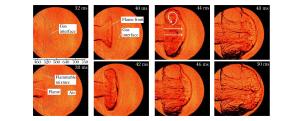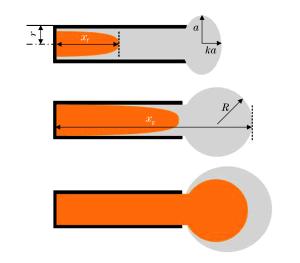| [1] |
CLANET C, SEARBY G. On the "tulip flame" phenomenon[J]. Combustion and Flame, 1996, 105(1/2):225-238. doi: 10.1016-0010-2180(95)00195-6/
|
| [2] |
BYCHKOV V, AKKERMAN V, FRU G, et al. Flame acceleration in the early stages of burning in tubes[J]. Combustion and Flame, 2007, 150(4):263-276. doi: 10.1016/j.combustflame.2007.01.004
|
| [3] |
VALIEV D M, AKKERMAN V, KUZNETSOV M, et al. Influence of gas compression on flame acceleration in the early stage of burning in tubes[J]. Combustion and Flame, 2013, 160(1):97-111. doi: 10.1016/j.combustflame.2012.09.002
|
| [4] |
NITSCHE M, KRASNY R. A numerical study of vortex ring formation at the edge of a circular tube[J]. Journal of Fluid Mechanics, 1994, 276(1):139-161. http://www.wanfangdata.com.cn/details/detail.do?_type=perio&id=S0022112094002508
|
| [5] |
DIDDEN N. On the formation of vortex rings:rolling-up and production of circulation[J]. Zeitschrift für Angewandte Mathematik und Physik (ZAMP), 1979, 30(1):101-116. doi: 10.1007/BF01597484
|
| [6] |
SHEN X, WANG Q, XIAO H, et al. Experimental study on the characteristic stages of premixed hydrogen-air flame propagation in a horizontal rectangular closed duct[J]. International Journal of Hydrogen Energy, 2012, 37(16):12028-12038. doi: 10.1016/j.ijhydene.2012.05.084
|
| [7] |
MARGOLIS G H. Nonsteady flame propagation[J]. Combustion Science and Technology, 1980, 22:143-169. doi: 10.1080/00102208008952379
|
| [8] |
MARKSTEIN G H. A shock-tube study of flame front-pressure wave interaction[C]//Symposium (International) on Combustion. Elsevier Inc., 1957, 6(1): 387-398. http://www.sciencedirect.com/science/article/pii/S008207845780054X
|
| [9] |
KERAMPRAN S, DESBORDES D, VEYSSIERE B. Study of the mechanisms of flame acceleration in a tube of constant cross section[J]. Combustion Science and Technology, 2000, 158(1):71-91. doi: 10.1080/00102200008947328
|
| [10] |
XIAO H, MAKAROV D, SUN J, et al. Experimental and numerical investigation of premixed flame propagation with distorted tulip shape in a closed duct[J]. Combustion and Flame, 2012, 159(4):1523-1538. doi: 10.1016/j.combustflame.2011.12.003
|
| [11] |
XIAO H, SUN J, CHEN P. Experimental and numerical study of premixed hydrogen/air flame propagating in a combustion chamber[J]. Journal of Hazardous Materials, 2014, 268(3):132-139. http://www.wanfangdata.com.cn/details/detail.do?_type=perio&id=JJ0232475592
|
| [12] |
PONIZY B, CLAVERIE A, VEYSSIÉRE B. Tulip flame-the mechanism of flame front inversion[J]. Combustion and Flame, 2014, 161(12):3051-3062. doi: 10.1016/j.combustflame.2014.06.001
|
| [13] |
HUANG Y, SUNG C J, ENG J A. Laminar flame speeds of primary reference fuels and reformer gas mixtures[J]. Combustion and Flame, 2004, 139(3):239-251. doi: 10.1016/j.combustflame.2004.08.011
|
| [14] |
TURNS S R. An introduction to combustion:concepts and applications[M]. McGraw-Hill Education, 1961:543.
|
| [15] |
LAW C K. Combustion physics[M]. Cambridge University Press, 2010.
|







 下载:
下载:







